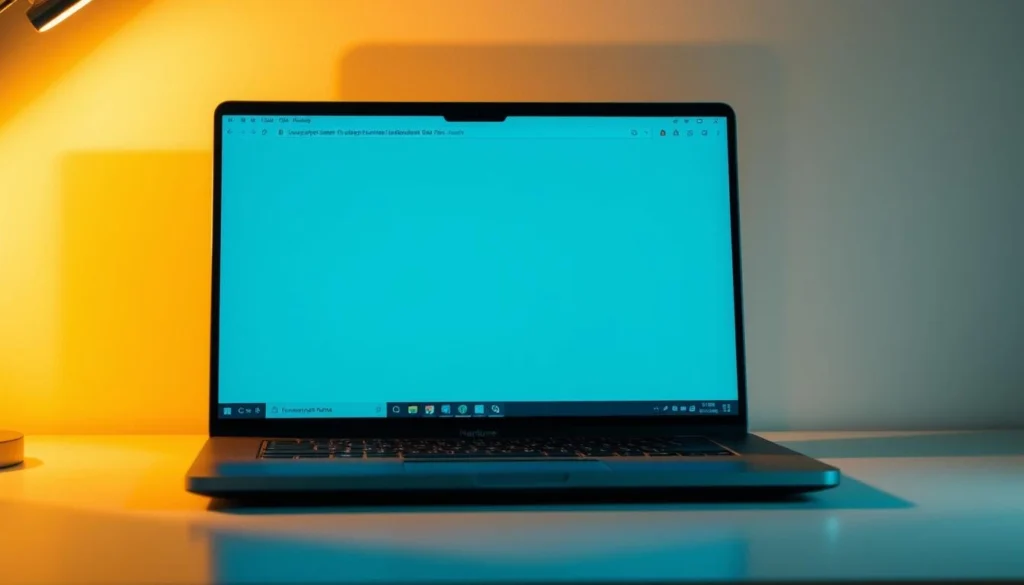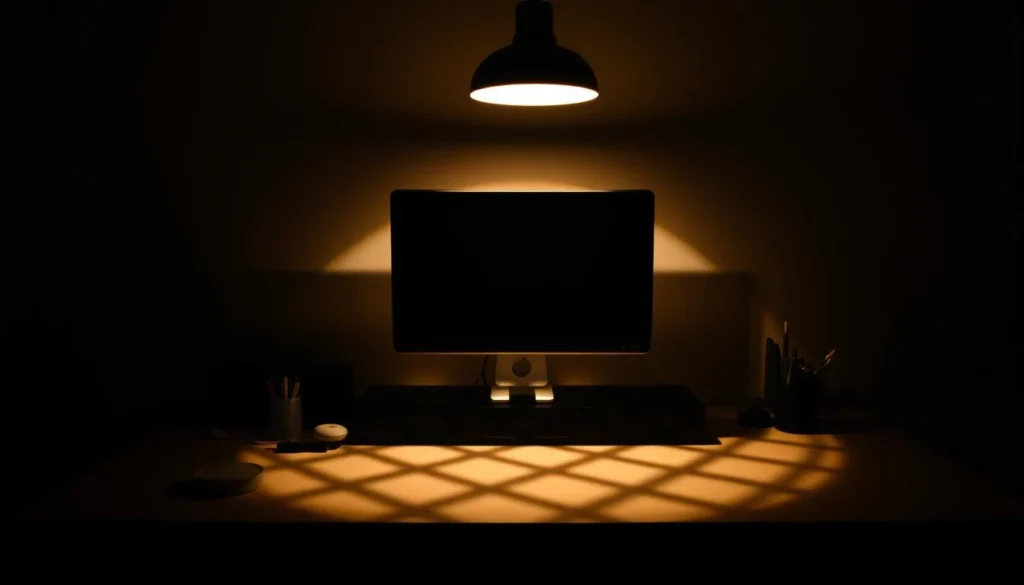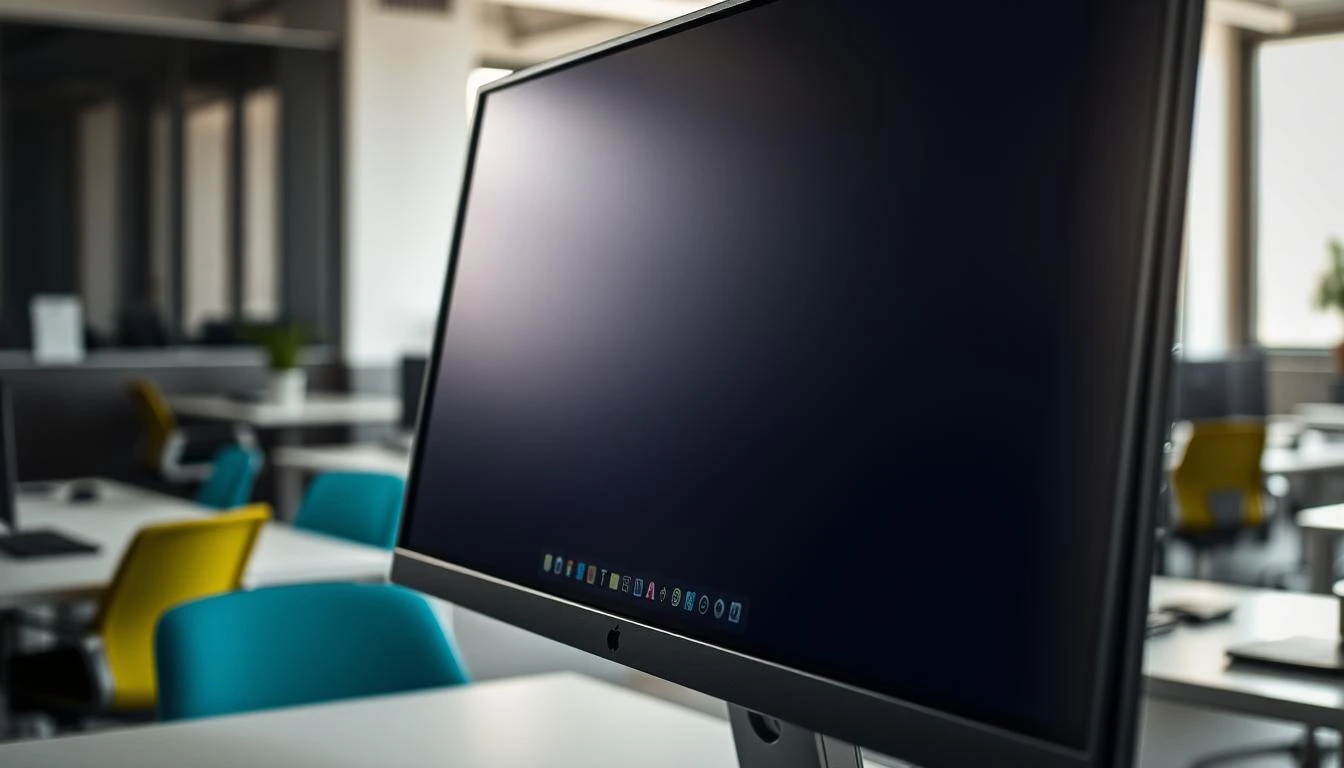Do you see unwanted shadows on your monitor or laptop display? This can be really annoying, whether you’re working or playing games. The good news is fixing the monitor shadow problem is easier than you might think.
People often ask why their screen shows shadows. It could be because of loose video cables or old display drivers. Luckily, just checking and updating these can often solve the problem. In this article, we’ll show you how to find and fix the laptop shadow fix and other display problems.
to get more infomation about computers
Key Takeaways
- Check video cables for loose connections
- Update display drivers to the latest version
- Adjust display settings for optimal performance
- Run a diagnostic test on your monitor or laptop
- Consider professional help if issues persist
What Causes Computer Screen Shadow Problems
It’s important to know why computer screens show shadows. Shadows on screens, also known as ghost images, can come from many sources. These include hardware problems, software issues, or user settings.
Different Types of Screen Shadows Explained
There are many kinds of screen shadows. Each has its own reasons for happening. Here are a few:
- Ghosting: This happens when pixels are slow to change. It makes moving objects leave a trail.
- Shadow Images: These are caused by showing the same image for too long. They leave a lasting mark on the screen.
- Monitor Shadow Lines: These are lines that show up on the screen. They can be due to hardware problems or bad cables.
How to Identify Your Specific Shadow Issue
To fix the shadow problem, you need to find out why it’s happening. Ask yourself:
- Does the shadow only show up with certain apps or content?
- Is the shadow always there, or does it change with different things on the screen?
- Does changing the monitor settings or display options help?
Knowing these things helps you figure out what to do next.
Common Misconceptions About Screen Shadows
Many people think screen shadows mean their monitor is going bad. But that’s not always true. Sometimes, a simple fix or software update can solve the problem. Also, bad cable shielding can cause ghosting or shadows on your screen.
Understanding the different kinds of screen shadows and why they happen is a big step. Whether it’s tweaking your monitor settings, updating drivers, or fixing hardware, finding the cause is the first step to fixing it.
Quick Diagnostic Steps for Monitor Shadow Issues
To fix shadows on your monitor, start with quick checks. These steps can find the problem and maybe fix it easily.
Visual Inspection Techniques
First, look at your monitor for damage. Check for cracks and make sure it’s connected right. A shadow might be from a loose connection or damage.
Check the video cables for damage. A bad cable can cause shadows and flickering. Try a Premium HDMI cable for better quality, if you’re using HDMI.
Testing with Different Input Sources
Try your monitor with a different device to see if the shadow stays. If it does, the problem is with the monitor. But if it goes away, it might be the other device.
Using Built-in Monitor Test Patterns
Many monitors have test patterns to find problems. Go to your monitor’s menu to find this feature. It can show if the shadow is from hardware or software.
| Diagnostic Step | Purpose | Potential Fix |
|---|---|---|
| Visual Inspection | Identify physical damage or loose connections | Tighten connections or replace damaged parts |
| Testing with Different Input Sources | Determine if the issue is with the monitor or input source | Adjust or replace the problematic device or cable |
| Using Built-in Monitor Test Patterns | Diagnose if the issue is hardware or software related | Update software or replace faulty hardware |
By doing these quick checks, you can figure out why your monitor has shadows. Then, you can fix it.
Simple Solutions to Computer Screen Shadow Problem
Don’t let screen shadows ruin your computer time. There are easy fixes. Screen shadow problems can be annoying, but fixing them is simple. These steps can greatly improve your screen’s look.
Checking and Replacing Video Cables
A bad or loose video cable often causes shadows. Check your video cables first. Make sure all cables are well connected to both your monitor and computer. If your cable is old, get a new one that fits your monitor’s resolution.
Try using a different HDMI port or a new HDMI cable. This can fix shadow problems caused by signal loss.
Adjusting Basic Monitor Settings
Changing your monitor’s basic settings can help too. Start by tweaking brightness and contrast.
Brightness and Contrast Optimization
Right brightness and contrast make a big difference. Here’s how to adjust:
- Lower brightness for dark rooms, higher for bright ones.
- Boost contrast to make light and dark areas clearer.
| Setting | Recommended Adjustment |
|---|---|
| Brightness | Lower for dark environments, higher for bright environments |
| Contrast | Higher for clearer distinction between light and dark |
Color Calibration Techniques
Calibrating your monitor’s colors can also help. Most modern monitors have preset modes. Try these modes or adjust colors manually to reduce shadows.
Restarting and Power Cycling Your Devices
At times, just restarting is the answer. Power cycling your monitor and computer can fix temporary problems. Turn off, unplug, wait a minute, then plug back in and start again.
By trying these steps, you can often fix shadow problems easily. You won’t need to know a lot of tech stuff or get help from experts.
How to Fix Ghosting on Computer Screens
Ghost images on your computer screen can be annoying. Knowing the cause is the first step to fixing it. Ghosting is when moving objects leave trails on your screen. This is often due to slow pixel response times or wrong graphics settings.
Understanding Screen Ghosting vs. Shadows
It’s important to know the difference between ghosting and shadows. Both can affect your screen, but they have different causes. Ghosting is usually about the display’s response time and the graphics card’s performance. Shadows are often from lighting, screen calibration, or cable problems.
Adjusting Response Time Settings
Slow response time is a main cause of ghosting. Most modern monitors let you change the response time in settings. Lowering the response time can help reduce ghosting. But, be careful not to set it too low, as it can cause other issues.
Graphics Card Settings for Ghosting Reduction
Your graphics card is key in how images look on your screen. Changing graphics card settings can help lessen ghosting.
NVIDIA Control Panel Solutions
For NVIDIA users, open the NVIDIA Control Panel. Adjust the “Response Time” or turn on “ULMB” (Ultra Low Motion Blur) to reduce ghosting.
AMD Radeon Settings Solutions
AMD Radeon users can tweak the “Response Time” in Radeon Settings. Some AMD cards also have “Pixel Response” boosting. This can be turned on to lessen ghosting.
Gaming-Specific Ghosting Solutions
Gamers often see ghosting in fast games. Turning on G-Sync (for NVIDIA) or FreeSync (for AMD) helps. It syncs the monitor’s refresh rate with the GPU’s frame rate, cutting down ghosting and screen tearing.
By understanding ghosting causes and using these fixes, you can make your screen better. Enjoy a clearer view.
Resolving LCD/LED Monitor Shadow Issues
Shadow problems on LCD and LED monitors can be fixed with the right steps. These issues include backlight bleeding, clouding, and uneven light.
Diagnosing Panel Problems
First, check the screen for damage or defects. This is the first step to solve LCD/LED monitor shadow issues.
- Check for any physical damage to the screen.
- Look for signs of backlight bleeding or clouding.
- Verify if the issue persists across different input sources.
Fixing Backlight Bleeding and Clouding
Backlight bleeding and clouding are common problems. They can cause shadows on LCD/LED monitors. Try adjusting the monitor settings or using calibration tools to fix these issues.
Steps to Fix Backlight Bleeding:
- Adjust the brightness and contrast settings.
- Use calibration software to optimize the display.
- Check for firmware updates for your monitor.
Addressing Uneven Illumination
Uneven light can cause shadow issues. Try adjusting the monitor’s settings or using external tools to fix this.
| Adjustment | Description | Effect on Shadow Issues |
|---|---|---|
| Brightness | Adjusting the overall brightness of the screen. | Can help reduce shadow visibility. |
| Contrast | Adjusting the difference between light and dark areas. | Can improve shadow clarity. |
| Calibration | Using software or hardware to optimize display settings. | Can significantly reduce shadow issues. |
Repairing Pressure Damage on LCD Screens
Pressure damage can cause shadow issues on LCD screens. If you find pressure damage, you might need professional help or a new screen.
Prevention is key:Avoid applying pressure to the screen to prevent damage.
By following these steps, you can solve LCD/LED monitor shadow problems. This will improve your viewing experience.
Fixing Laptop Screen Shadow Problems
Fixing laptop screen shadows needs knowing why they happen and how to fix them. Laptop screens face many issues, like shadows, because of their small size and many parts.
Laptop-Specific Shadow Causes
Laptop screens can get shadows for several reasons. One big reason is backlight bleeding. This is when the backlight leaks through the LCD panel, making the screen uneven.
Another big reason is the hinge mechanism. If the hinges are damaged or worn out, the screen can misalign. This causes shadow problems.
Common Causes of Laptop Screen Shadows:
- Backlight bleeding
- Hinge damage or wear
- Loose connections
- Graphics driver issues
Software Solutions for Laptop Displays
Before fixing hardware, try software fixes. Updating your graphics drivers is a simple step. It can solve many display problems, including shadows.
“Outdated drivers can lead to a myriad of display problems. Regular updates can prevent issues like screen shadows.”
Changing display settings can also help. Lowering the screen brightness or adjusting the display can sometimes fix shadow problems.
| Software Solution | Description |
|---|---|
| Update Graphics Drivers | Ensures you have the latest fixes and improvements for your graphics card. |
| Adjust Display Settings | Changing brightness, contrast, and calibration can help reduce shadows. |
Addressing Hinge-Related Shadow Issues
If the shadow issue is from the hinge, check and fix or replace it. A damaged hinge can make the screen sit wrong. This uneven pressure can cause shadows.

When to Consider Screen Replacement
At times, shadows mean a bigger problem with the LCD panel. If software fixes and hinge adjustments don’t work, it might be time for a new screen.
Signs that indicate screen replacement might be necessary:
- Persistent shadows despite troubleshooting
- Visible cracks or damage on the screen
- Failure of software solutions to resolve the issue
By knowing why shadows happen and trying both software and hardware fixes, you can fix laptop screen shadow problems. This will make your display work better.
Dealing with Screen Burn-in and Image Persistence
Screen burn-in is a problem that needs fixing. It happens when a static image stays on a screen too long. This leaves a ghostly mark.
Identifying Burn-in vs. Image Retention
It’s important to know the difference between burn-in and image retention. Image retention goes away after a while. Burn-in stays forever.
- Temporary Image Retention: This is from showing the same image briefly.
- Permanent Burn-in: This is from showing static content for a long time.
OLED-Specific Shadow and Burn-in Solutions
OLED screens are more likely to get burn-in. To help, OLED makers use pixel shifting and image retention compensation.
- Change your display settings to lower brightness and adjust the pixel refresh rate.
- Use pixel shifting, which moves the image a bit.
Prevention Methods for All Display Types
Stopping burn-in before it starts is best. Here are tips for all screens:
- Don’t keep static images on for too long.
- Keep your screen’s brightness and contrast right.
- Use screen savers or turn off your screen when idle.
Recovery Techniques and Pixel Refreshers
If burn-in has already happened, there are ways to fix it. Pixel refreshers and screen repair software can help.
Pixel Refreshers: Many screens have built-in pixel refreshers. They flash the screen with different colors to prevent burn-in.
By knowing why screen burn-in happens and acting early, you can keep your screen looking good for longer.
Advanced Troubleshooting for Monitor Shadow Lines
Monitor shadow lines can be frustrating. But, there are steps you can take to fix them. Knowing the cause is the first step to finding a solution.
Fixing Vertical and Horizontal Line Shadows
Vertical and horizontal line shadows can come from many places. This includes the display panel or graphics card issues. First, check your monitor for any damage or wear.
If it’s not physical damage, try changing your monitor’s settings. Sometimes, a simple setting change can fix the problem. For more serious issues, you might need to look at advanced settings or update your graphics card drivers.

Driver Updates and Reinstallation Procedures
Outdated or corrupted graphics card drivers can cause shadow lines. Make sure your drivers are current. You can check this on your computer manufacturer’s website or through the device manager.
If updating doesn’t work, try reinstalling the drivers. Uninstall the current drivers and let your system reinstall them. This can fix problems with corrupted files.
Testing with Different Devices and Ports
The problem might not be with your monitor. Try using a different device or port. This can help figure out if the issue is with the monitor, device, or connection.
Addressing Graphics Card-Related Shadow Issues
Graphics card problems can also lead to shadow lines. If you’ve updated your graphics card or drivers, try going back to a previous version. Adjusting graphics card settings, like refresh rate or resolution, might also help.
| Troubleshooting Step | Potential Solution |
|---|---|
| Check physical condition | Inspect for damage or wear |
| Adjust monitor settings | Change display settings |
| Update graphics card drivers | Resolve issues with outdated drivers |
| Test with different devices/ports | Isolate the source of the problem |
| Adjust graphics card settings | Change refresh rate or resolution |
When to Seek Professional Help
Not all computer screen shadow problems can be fixed at home. Sometimes, you need an expert. If you’ve tried many fixes and the problem stays, it’s time to get professional help for your lcd/led monitor shadow repair.
Signs of Serious Hardware Failure
There are signs that your monitor or laptop screen has serious problems. These include:
- Persistent shadow or ghosting that doesn’t improve with software adjustments
- Visible cracks or damage to the screen
- Flickering or completely dark areas on the display
- Physical damage to the monitor or laptop that affects the display
If you see these signs, stop using the device. Using a damaged screen can cause more harm. This could make the repair more expensive or even need a new screen.
Warranty Considerations and Manufacturer Support
Before getting help from someone else, check if your device is under warranty. Many makers offer warranties that cover repairs or new devices. Contact the maker’s support to see what you can do:
- Review the warranty terms and conditions
- Reach out to customer support for guidance on the next steps
- Follow the manufacturer’s procedure for filing a claim or scheduling a repair
Using the maker’s support can save you money on lcd/led monitor shadow repair.
Finding Reliable Repair Services
If your device is no longer under warranty, find a good repair service. Look for:
- Authorized service centers for your device’s brand
- Reputable, independent repair shops with positive reviews
- Technicians with experience in monitor or laptop screen repairs
Make sure the repair service gives a clear diagnosis and estimate before fixing your device.
Cost-Benefit Analysis: Repair vs. Replacement
When dealing with a stubborn computer screen shadow issue, decide if to repair or replace. Think about:
- The age and overall condition of your monitor or laptop
- The cost of the repair compared to the device’s original price or its current market value
- The benefits of upgrading to a newer model, like better performance or features
Doing a cost-benefit analysis will help you choose the best option for your needs and budget.
Conclusion
Dealing with a computer screen shadow problem can be frustrating. But, there are steps you can take to fix it. We’ve looked at many causes and solutions in this article.
Wondering why your screen shows shadows? It might be due to monitor settings, video cables, or graphics card issues. By checking and adjusting these, you can often solve the problem. For more complex issues, like screen burn-in or ghosting, specific fixes like adjusting response time settings or using pixel refreshers can help.
The web has lots of info on fixing computer screen shadow problems. By following the steps in this article, you should be able to find and fix your monitor shadow issue. Whether it’s a simple fix or needs professional help, knowing the cause is the first step to a clear screen.
FAQ
What causes shadows on my computer screen?
Shadows on screens can come from many things. This includes loose or broken video cables, wrong monitor settings, graphics card problems, or issues with the display panel itself.
How do I diagnose a shadow problem on my monitor?
First, look at your screen and cables. Try different input sources and use built-in test patterns to find the problem.
Can a loose video cable cause shadows on my screen?
Yes, a loose or damaged video cable can lead to shadows or other display problems. Make sure all cables are well connected to both the monitor and computer.
What is the difference between ghosting and shadows on a computer screen?
Ghosting is when moving objects leave a trail on the screen. Shadows are static dark spots. Ghosting is often due to response time settings. Shadows can be caused by many things.
How can I fix ghosting on my computer screen?
To fix ghosting, adjust your monitor’s response time settings. Update your graphics card drivers. Also, use gaming features that reduce ghosting if they’re available.
What is screen burn-in, and how can I prevent it?
Screen burn-in is a permanent ghost image from static content. To avoid it, use screen savers and adjust display settings. Also, don’t show static images for too long.
Can I fix screen burn-in on my OLED display?
OLED displays can get burn-in. Try pixel refreshers or burn-in correction tools. But, some burn-in might not go away.
When should I seek professional help for my computer screen shadow problem?
If you’ve tried everything and the problem stays, or if you see serious hardware failure, get professional help. Also, if your display is under warranty, contact the maker for support.
How can I prevent shadow problems on my laptop screen?
To avoid shadow problems on your laptop screen, be gentle with it. Don’t press on the screen. Keep your laptop’s software and drivers current.
Can a graphics card issue cause shadows on my computer screen?
Yes, graphics card issues can lead to shadows. Try updating your graphics card drivers. If you can, test with a different graphics card.
What is backlight bleeding, and how can I fix it?
Backlight bleeding is when light leaks around an LCD screen’s edges or corners. It’s often a manufacturing flaw. Try adjusting display settings or using a screen calibration tool to lessen it.
How do I know if my screen shadow problem is hardware or software related?
Try troubleshooting steps like updating drivers and adjusting settings. If the problem stays the same with different sources and settings, it’s likely a hardware issue.




